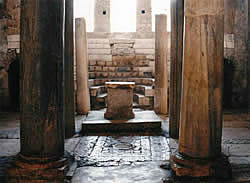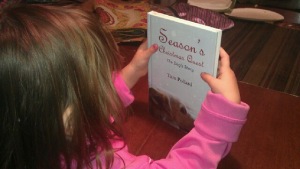First, the name is the same, but it’s all in the pronunciation of the name. He was known far and wide as “Saint Nicholas”, a man of miracles and generosity. Stories about him grew and spread to other nations and the pronunciation of his name, with a variation of spellings, changed to suit the accent and dialect of each town. For example, Saint Nicholas to the Scandinavians went from “Sant Niklaus” to “Santna Klaus” (sounding very similar to Santa Claus) to “Sinterklaas”. Even the Germans, spelled it nearly the same with variations of “Zinterklos” or “Zintner Klaas”. (Klaas, Klaus and Claus are also short for Niklaus or Nicholas) He was also known as “Kris Kringle” or “Kris Kind” which means “Christ Kind” or “child of Christ”, a name also used today.
By the time people from these lands began to immigrate to America, they brought with them their spellings and pronunciations and the name eventually turned into “Santa Claus”, and thereafter the legends grew into fantasy.
But, the true story of Nicholas, begins in the village of Patara (southwest coastal city in Turkey), where he was born of Greek parents on March15, 270 AD, lived as a devout believer and follower of Jesus Christ, and died on December 6, 343 AD. He spent most of his life in the nearby city of Myra. His parents were wealthy and raised him to be a devout Christian. They both died in an epidemic and Nicholas inherited a vast fortune, but harkening to Jesus’ words to the rich man, “Go and sell all your possessions and give the money to the poor, and you will have treasure in heaven”, he dedicated his life to assist the less fortunate and serving God. He became known throughout the land for his generosity to those in need, his love for children, and his concern for sailors and ships.
Persecution of Christians (a term coined in the year 42AD in Antioch of those who followed Christ) continued off and on over the next centuries after the death of Jesus, but in 261 AD, Gallienus issued an edict of tolerance that lasted for nearly 40 years. Nicholas was born into this peace, but then around 303 AD, when Nicholas was around 33 years old, Roman Emperor Diocletian, began to ruthlessly persecute Christians. Nicholas was an ordained Bishop in Myra by then and suffered for his faith, exiled and imprisoned. The prisons were so full of Christians, there was no room for the real criminals. Diocletian also divided Rome into two political and cultural sections, East and West, which caused the beginning of the Roman decline.
By 311, Constantine issued an edict ending persecution of Christians and then in the year 325, Bishop Nicholas was in attendance at Constantine’s famous Council of Nicaea. Nicholas was profoundly against the teachings of the Arians, who taught against the divinity of Christ and the Council’s principal action was the condemnation of Arianism. The council also contributed to formulation of the Nicene Creed, fixed the date for the observance of Easter, passed regulations concerning clerical discipline, and adopted the civil divisions of the Empire as the model for the jurisdictional organization of the Church.
Life went on and Bishop Nicholas continued his practice of helping those in need. The most popular story regarding Nicholas was about a poor man with three daughters of marrying age. In those days, and for many centuries after, a young woman’s father had to offer prospective husbands something of value–a dowry– to go along with the bride. Without a dowry, a woman was unlikely to marry, but the larger the dowry, the better the chance that a young woman would find a good and decent husband. The poor man had no dowry for his daughters and was afraid that they would need to be sold into slavery. Word of this came to Nicholas, and mysteriously, a bag of gold appeared in the home for each of them. The first two bags had, evidently, been secretly tossed through an open window, and are said to have landed in stockings or shoes left before the fire to dry. One story tells that the father tried to spy on the benefactor and watched out the window for him, but Nicholas tricked him by throwing the third bag down the chimney instead. This story led to the custom of children hanging stockings or putting out shoes, eagerly awaiting gifts from Saint Nicholas and they were not often disappointed. (It also led to the current idea of Santa coming down the chimney to leave those gifts).
There were many miracles attributed to him, but the most significant came after his death. He died on December 6 in 343 AD and was buried in his own church, where a unique and strange oily substance formed in his grave. It was called manna or myrrh and the rose scented substance was said to have healing powers, which then fostered the growth of devotion to Nicholas. The anniversary of his death, December 6th, became a day of celebration, and St. Nicholas Day was celebrated extensively.
Over the centuries, St. Nicholas’ tomb in Myra became a popular place of pilgrimage as the manna continued to flow. As Myra was a seaport, sailors heard the stories of the healing miracles and carried them all over the world. People flocked to Myra to see his shrine and Myra benefited commercially because of that. But then Myra fell under the control of the invading Seljuk Turks, and Italian merchants in both Venice and Bari, saw an opportunity to bring such advantage to their own cities. Their motives were opportunistic in part, but also spiritual, as there was real fear that pilgrimage could become difficult and dangerous, and that the shrine would even be desecrated by the unbelieving Turks.
Early in 1087, three ships with sailors and merchants from Bari stopped in Myra on their way home from Antioch. When they visited the tomb, the monks showed them where the manna was extracted and where the body was lain. Later they came back and broke open the tomb with an iron bar and escaped with the bones to the southeast coast of Italy. Before arriving there, they stopped at a nearby port to make a beautiful casket to hold the relics and when they arrived in Bari the townspeople thronged to the harbor to welcome the saint’s remains. The returning men made a solemn vow to build a magnificent church to honor St. Nicholas. To this day pilgrims and tourists visit Bari’s great Basilica di San Nicola.
In the late 1950s, during a restoration of the chapel, a team of hand-picked scientists came to photograph and measure the contents of the crypt grave. In the summer of 2005, the report of these measurements was sent to a forensic laboratory in England. The review of the data revealed that the historical St. Nicholas was barely five feet in height and had a broken nose (probably received during his incarceration). In 2009, Turkey requested that the bones be returned. The substance is reported to continue to flow to this day, but now the unbelieving world attributes it to seawater.
Enter Santa Claus…On December 23, 1773; the Rivington’s Gazette in New York City may have been the first official recorded recognition of the name change when they wrote “St. Nicholas, otherwise known as Santa Claus”. Although the name, itself, had not changed, the pronunciation had, so therefore the spelling also changed. After that, his persona began to change also, but in a satirical and mocking way.
Dutch immigrants, who strongly celebrated Saint Nicholas, had settled in the Hudson Valley in New York and brought with them their legends and stories. Washington Irving, who wrote the Legend of Sleepy Hollow, had moved nearby and became familiar with the town of Sleepy Hollow with its quaint Dutch customs and local ghost stories. In his satirical A History of New York from the Beginning of the World to the End of the Dutch Dynasty, Irving makes dozens of references to a Saint Nicholas that flies over treetops and brings gifts down chimneys. It was purposely published on the feast day of St. Nicholas, December 6, 1809…“And when St. Nicholas had smoked his pipe, he twisted it in his hatband, and laying his finger beside his nose gave the astonished Van Kortlandt a very significant look; then mounting his wagon he returned over the tree tops and disappeared.” Book II, Chapter V.
That satire was so well received, that embellished knockoffs came right behind it. Some years later a William Gilley published the didactic Sancte Claus in 1821 in which he wrote in part: “Old Santeclaus with much delight, His reindeer drives the frosty night, O’er chimney tops and tracks of snow, To bring his yearly gifts to you.” He then goes on to describe the types of toys children should play with.
Clement Moore, a professor at the General Theological Seminary of the Protestant Episcopal Church, was greatly influenced by the satirical writings of Washington Irving, and was a neighbor of William Gilley. He copied from Irving’s History with his poem A Visit from St. Nicholas (Twas the Night before Christmas) and incorporated the writings of Gilley. But his story portrays St. Nicholas as a magical and fanciful, tiny pipe-smoking elf-like man in a red suit, with a round belly and a sleigh of toys including Gilley’s flying reindeer, which were now very tiny also. It was published in the New York Sentinal on December 23, 1823.
It was all fun and games, but the world began to become more secularized and this “Santa Claus” was embraced as the new hero. In 1848 illustrations began to be added to the work that eventually changed the elf to human size and over time new stories were embellished and added to the original that housed him at the North Pole employing elves in a toy making shop, and it goes on from there.
Nicholas of Myra was an important and instrumental part of church history, but it seems as if the veneration of the Saint had become so pronounced in many parts of the world, that stories of his works and miracles had even overshadowed those of Christ. It is possible that the early American satirical and fantastical stories were mockingly written to bring attention to that fact by the use of hyperbole, and that the Jesus that Nicholas, himself, worshipped…the one he had served his entire life and suffered in prison for…had been forgotten.






